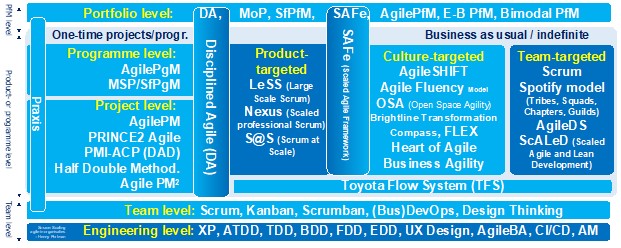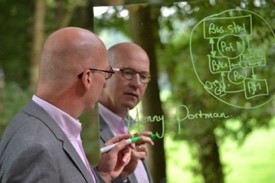FEATURED PAPER
By Henny Portman
The Netherlands
Some years ago, you could say “Scrum is agile” and ask “is Agile Scrum?” Now we know there is much more flesh on the bones. At this moment there are more than fifty known and less known agile approaches, frameworks or methods available. To get a first impression of the different approaches, I try to bring some structure in the jungle to approaches, methods and frameworks. In Figure 1, I position the best-known agile approaches in a structure. The approaches, frameworks or methods are positioned within the ‘One-time programs / projects’ sections or within ‘Business as usual’ / indefinite, or both.

Fig. 1 Overview Agile approaches, frameworks and methods[1]
On the other side the approaches, frameworks or methods are clustered around team, product or programme and portfolio level. In the dark blue boxes in Figure 1 we see agile approaches that are only applicable in IT-focused organizations. All other approaches can be used within IT and non-IT-oriented organizations (light blue coloured). I haven’t mapped all the known approaches, frameworks and methods in this figure, and to be honest, I think there is a lot of duplication and probably commercial drivers play a role too to ‘develop’ the next kid on the block without added value in comparison with the existing approaches, frameworks or methods.
The team level, including Scrum and Kanban, is applicable in both IT-oriented and non-IT-oriented products and services development and operations. The engineering level focuses specifically on IT-oriented product development. The one-time, temporary projects and programme frameworks and methods are suitable for both IT and non-IT. The permanent umbrella frameworks (both product-targeted and team-targeted) focus specifically on IT and product development and the Culture-targeted approaches help organisations to increase their agility.
Team level
If we start at the team level in Figure 1, then we see of course Scrum[2] as described by Ken Schwaber and Jeff Sutherland in their Scrum Guide. In addition, you will see frameworks such as Kanban[3] (as described in the Kanban Guide for Scrum Teams), Scrumban[4] and DevOps[5] or BusDevOps. The team level can be used both within the IT environment and the non-IT environment. At this team level we can position the following IT frameworks too: Crystal Development Framework[6] (developed by Alistair Cockburn), Agile Unified Process (AUP)[7] as a simplified version of Rational Unified Process (RUP)[8] which was superseded by Disciplined Agile Development (DAD) which was superseded by Disciplined Agile (DA)[9]. Adaptive Software Development (ASD) succeeded RADical Software Development (RSD, developed by Jim Highsmith and Sam Bayer). Modern Agile[10] could be positioned here too. Modern Agile is a community for people interested in uncovering better ways of getting awesome results. It leverages wisdom from many industries, is principle driven and framework free. The guiding principles are: Make people awesome, make safety a prerequisite, experiment & learn rapidly and deliver value continuously.
More…
To read entire paper, click here
How to cite this paper: Portman, H. (2020). A new bird’s eye view on the agile forest; PM World Journal, Vol. IX, Issue X, October. Available online at https://pmworldlibrary.net/wp-content/uploads/2020/09/pmwj98-Oct2020-Portman-a-new-birds-eye-view-on-agile-forest.pdf
About the Author

Henny Portman
The Netherlands
![]()
Henny Portman, owner of Portman PM(O) Consultancy and partner of HWP Consulting, has 40 years of experience in the project management domain. He was the project management office (PMO) thought leader within NN Group and responsible for the introduction and application of the PMO methodologies (portfolio, programme and project management) across Europe and Asia. He trains, coaches and directs (senior) programme, project and portfolio managers and project sponsors at all levels, and built several professional (PM(O) communities.
He is an accredited P3O, PRINCE2, MSP, MoP, PRINCE2 Agile, AgilePM, AgilePgM, and AgileSHIFT trainer and a SPC4 SAFe consultant and trainer too. He is a P3M3 trainer and assessor and PMO Value Ring Certified Consultant. On behalf of IPMA he assesses (large and mega) projects for the Project Excellence Award. In addition, Henny is an international speaker and author of many articles and books in the PM(O) field and blogger (hennyportman.wordpress.com). Henny can be contacted at henny.portman@gmail.com.
[1] This picture is based on a simpler version in the book Scaling Agile in organizaties by Henny Portman, Van Haren Publishing, 2017
[2] https://www.scrumguides.org/index.html sketchy guide: https://www.paperturn-view.com/uk/sketchy-agile-guides/the-sketchy-guide-to-scrum?pid=OTc97558&v=2.3
[3] https://www.scrum.org/resources/blog/understanding-kanban-guide-scrum-teams
[4] https://leankit.com/learn/agile/what-is-scrumban/
[6] https://activecollab.com/blog/project-management/crystal-methods
[7] http://www.ambysoft.com/unifiedprocess/agileUP.html
[8] http://www.agilemodeling.com/essays/agileModelingRUP.htm
[9] http://disciplinedagiledelivery.com









